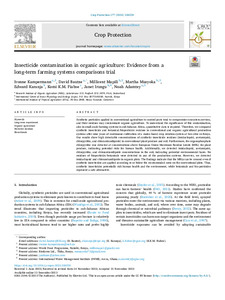| dc.contributor.author | Kampermann, I. |
| dc.contributor.author | Bautze, D. |
| dc.contributor.author | Mapili, M. |
| dc.contributor.author | Musyoka, M.W. |
| dc.contributor.author | Karanja, E. |
| dc.contributor.author | Fiaboe, K. |
| dc.contributor.author | Irungu, J. |
| dc.contributor.author | Adamtey, N. |
| dc.date.accessioned | 2024-03-11T11:14:05Z |
| dc.date.available | 2024-03-11T11:14:05Z |
| dc.date.issued | 2024-03 |
| dc.identifier.citation | Kampermann, I., Bautze, D., Mapili, M., Musyoka, M., Karanja, E., Fiaboe, K., ... & Adamtey, N. (2024). Insecticide contamination in organic agriculture: evidence from a long-term farming systems comparisons trial. Crop Protection, 177: 106529, 1-7. |
| dc.identifier.issn | 0261-2194 |
| dc.identifier.uri | https://hdl.handle.net/20.500.12478/8423 |
| dc.description.abstract | Synthetic pesticides applied in conventional agriculture to control pests tend to compromise ecosystem services, and their residues may contaminate organic agriculture. To understand the significance of this contamination, also in small-scale farming systems in sub-Saharan Africa, quantitative data is required. Therefore, we compared synthetic insecticide and botanical/biopesticide residues in conventional and organic agricultural production systems after nine years of continuous cultivation of a maize-based crop rotation system at two sites in Kenya. Our results show high detectable concentrations of synthetic insecticide residues (imidacloprid, acetamiprid, chlorpyrifos, and chlorantraniliprole) in conventional plant produce and soil. Furthermore, the organophosphate chlorpyrifos was detected at concentrations above European Union Maximum Residue Limits (MRL) for plant produce, indicating potential risks for human health. Additionally, we detected imidacloprid, acetamiprid, chlorpyrifos, and chlorantraniliprole concentrations in the soil, indicating potential environmental harm. No residues of biopesticide/botanicals were detected in any of the production systems. However, we detected imidacloprid and chlorantraniliprole in organic plots. The findings indicate that the MRLs can be crossed even if synthetic insecticides are applied according to or below the recommended rates on the conventional plots. Thus, synthetic insecticides potentially risk human health and the environment, while botanicals and bio-pesticides represent a safe alternative. |
| dc.description.sponsorship | Biovision Foundation for Ecological Development, Coop Sustainability Fund |
| dc.description.sponsorship | Liechtenstein Development Service |
| dc.description.sponsorship | Swiss Agency for Development and Cooperation |
| dc.format.extent | 1-7 |
| dc.language.iso | en |
| dc.subject | Organic Agriculture |
| dc.subject | Farming Systems |
| dc.subject | Pesticide Residues |
| dc.title | Insecticide contamination in organic agriculture: evidence from a long-term farming systems comparisons trial |
| dc.type | Journal Article |
| cg.contributor.crp | Roots, Tubers and Bananas |
| cg.contributor.affiliation | Research Institute of Organic Agriculture, Switzerland |
| cg.contributor.affiliation | International Centre of Insect Physiology and Ecology |
| cg.contributor.affiliation | International Institute of Tropical Agriculture |
| cg.coverage.region | Africa |
| cg.coverage.region | East Africa |
| cg.coverage.country | Kenya |
| cg.coverage.hub | Central Africa Hub |
| cg.researchtheme | Natural Resource Management |
| cg.identifier.bibtexciteid | KAMPERMANN:2024 |
| cg.isijournal | ISI Journal |
| cg.authorship.types | CGIAR and advanced research institute |
| cg.iitasubject | Agronomy |
| cg.iitasubject | Farming Systems |
| cg.iitasubject | Food Security |
| cg.iitasubject | Natural Resource Management |
| cg.iitasubject | Soil Fertility |
| cg.journal | Crop Protection |
| cg.notes | Open Access Article |
| cg.accessibilitystatus | Open Access |
| cg.reviewstatus | Peer Review |
| cg.usagerightslicense | Creative Commons Attribution 4.0 (CC BY 0.0) |
| cg.targetaudience | Scientists |
| cg.identifier.doi | https://doi.org/10.1016/j.cropro.2023.106529 |
| cg.iitaauthor.identifier | Komi Fiaboe: 0000-0001-5113-2159 |
| cg.futureupdate.required | No |
| cg.identifier.issue | 106529 |
| cg.identifier.volume | 177 |
| cg.contributor.acknowledgements | The authors wish to acknowledge the financial support from the Biovision Foundation for Ecological Development, Coop Sustainability Fund, the Liechtenstein Development Service (LED), and the Swiss Agency for Development and Cooperation (SDC). They also wish to thank the management of the Kenya Agricultural and Livestock Research Organization (KALRO) for offering the trial site at Thika and the management of Kiereini Primary School for offering the second trial site at Chuka. In addition, we want to thank Prof. Dr. Baldwyn Torto, who contributed significantly by proofreading the article. Finally, we extend our gratitude to the paper’s external reviewers for their valuable comments that helped further improve the manuscript. |

